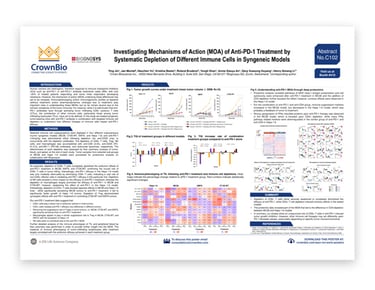- Services
- Therapeutic Areas
- Model Systems
- In Vitro
- In Vivo
- Technologies
- Service Type
- About Us
- Our Science
- Start Your Study Now
Ying Jin, Jan Muntel*, Haochen Yu*, Kristina Beeler*, Roland Bruderer*, Yongli Shan, Annie Xiaoyu An, Davy Xuesong Ouyang, Henry Qixiang Li
*Biognosys AG, Zurich, Switzerland 
To optimize immune checkpoint inhibitor use it’s important to fully understand which immune cell populations mediate response. For example, while it’s well known that anti-PD-1 antibodies work via activation of cytotoxic T cells, the contribution of other immune cell populations are not well defined.
To understand how different immune cell lineages impact anti-PD-1 efficacy, we combined anti-PD-1 treatment with different immune cell population depletion in MC38, CT-26, EMT6, and Hepa 1-6 murine syngeneic models. Proteomic analysis was also performed on tumor samples from selected MC38 and Hepa 1-6 model subgroups.
Your privacy is important to us.
We'll never share your information.
© 2024 Crown Bioscience. All Rights Reserved.


© 2024 Crown Bioscience. All Rights Reserved. Privacy Policy
2023-05-22
2021-10-26
landing_page
PDX/Databases